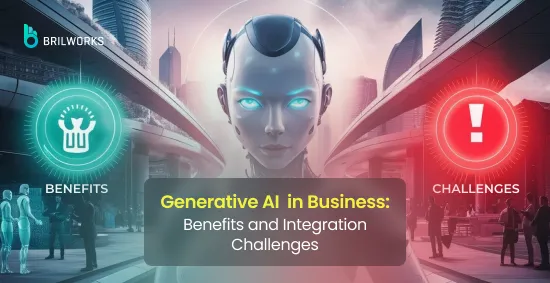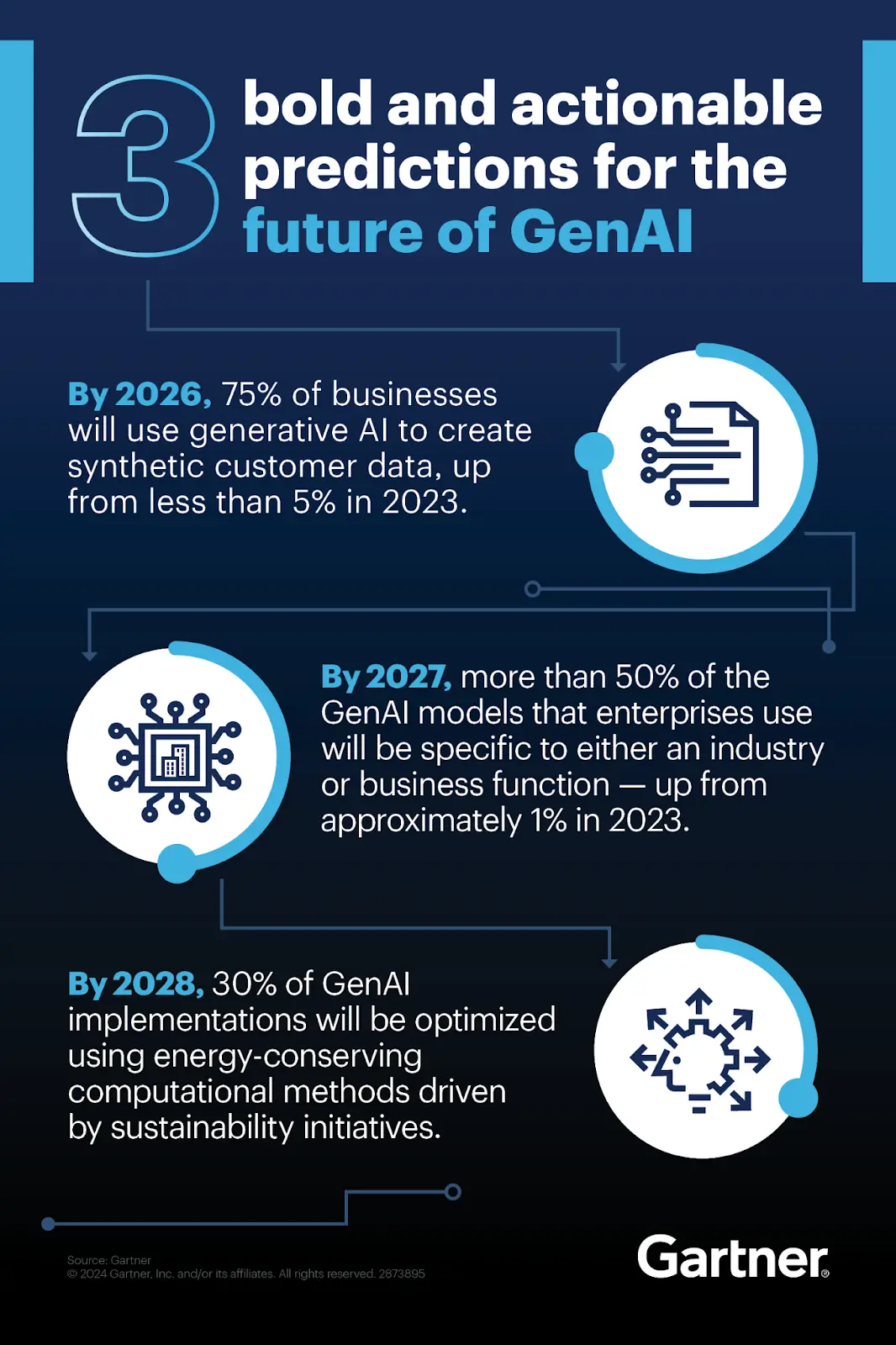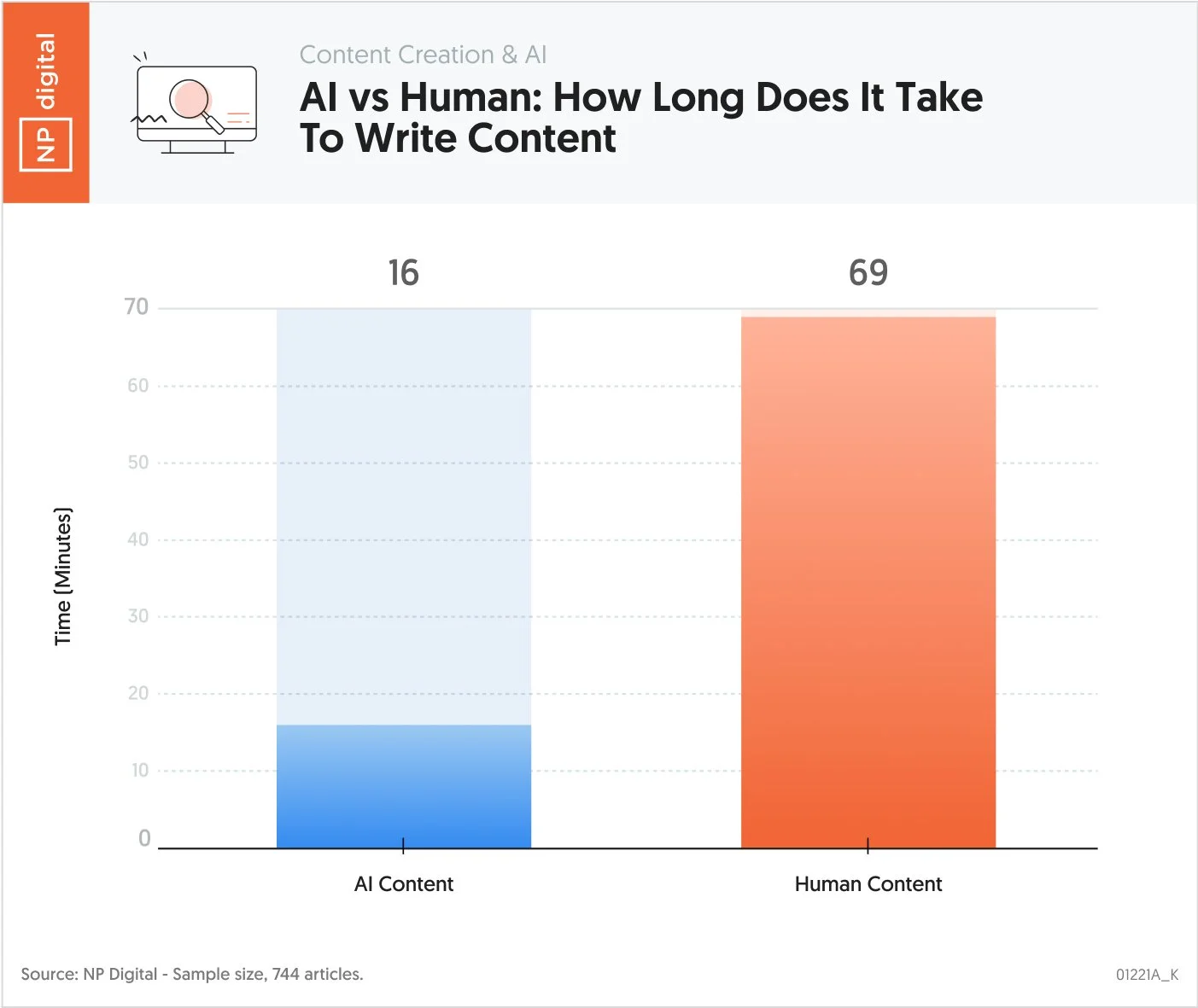COOPERATION MODEL
ARTIFICIAL INTELLIGENCE
PRODUCT ENGINEERING
DevOps & Cloud
LOW-CODE/NO-CODE DEVELOPMENT
INDUSTRY
FRONTEND DEVELOPMENT
CLOUD DEVELOPMENT
MOBILE APP DEVELOPMENT
LOW CODE/ NO CODE DEVELOPMENT
EMERGING TECHNOLOGIES








Generative AI technology is no longer a buzzword. It has already become a transformative force. In a report published by McKinsey, it could add trillions of dollars to the global economy. With the advancement in generative AI development, use cases of generative AI are growing beyond content generation across different industries.
From healthcare and finance to retail and logistics, businesses are exploring ways to leverage this technology for operational efficiency and smarter decision-making. As demand grows, the role of a generative AI development company has become crucial in helping enterprises build customized solutions tailored to their industry needs. These companies are not only enabling AI integration but also guiding organizations through safe, scalable, and ethical adoption.
Choosing the right generative AI development company can be a turning point for businesses aiming to gain a competitive edge. With the hype around generative continuing to mount, business leaders have started testing a small number of use cases and gathering more information on this technology.
According to a report, more than 50% of large organizations worldwide will move beyond general-purpose AI models to enhance their productivity and reduce costs by 2027.

Generative AI is gradually becoming a savior for many businesses, as generative AI applications can work on par with human professionals in routine tasks such as content creation and customer service. etc.
In addition, large organizations have already moved towards the development of tailored models for solving complex business problems.
This technology is empowering businesses to perform routine tasks and improve their services as it possesses tremendous capabilities to extract meaningful information from the mountains of data.
The adoption of generative AI in business will continue to rise, with the growth in tailored models in the upcoming years. However, this technology possesses some limitations that we will discuss in this article.
Generative AI is a type of computer program that can make new things. It can write stories, draw pictures, create music, or even write computer code. How does it do this? It looks at lots of examples of these things made by people and learns the patterns. Then, it uses what it learned to make something new that's similar to what a person might make.
Generative AI programs can learn from information and data. The more data they have, the better they can analyze and interpret it. This technology is becoming increasingly ubiquitous.
Considering the current scenario, more than 50% of content will no longer be generated by humans.

Generative AI can produce high-quality text, images, videos, and even audio tailored to specific audiences. Businesses use it to craft marketing campaigns, write product descriptions, or generate social media content at scale. For example, tools like this can churn out creative ad copy in seconds, saving time and resources.
From designing prototypes to simulating outcomes, generative AI accelerates R&D. Think of architects using it to generate building layouts or manufacturers optimizing parts for durability—faster and cheaper than traditional methods.
Chatbots and virtual assistants powered by generative AI (like me, perhaps?) can handle complex customer queries, offering personalized responses 24/7. This boosts satisfaction and cuts operational costs.
In industries like healthcare or finance, where data is king but privacy is a concern, generative AI can create synthetic datasets for testing and training without compromising real-world info.
Writing reports, summarizing meetings, or even coding—generative AI can take over repetitive tasks, freeing up humans for strategic work.
The tech isn’t flawless. It can produce biased, inaccurate, or nonsensical outputs (hallucinations, in AI speak). Businesses need robust oversight to ensure reliability—imagine a legal firm using AI-generated contracts with errors slipping through.
Intellectual property disputes are a minefield. If AI trains on copyrighted material, who owns the output? Plus, there’s the risk of misuse—like deepfakes damaging a brand’s reputation.
While the potential is huge, training or fine-tuning these models can be pricey, and integrating them into existing systems isn’t always seamless. Small businesses might struggle with the upfront investment.
Automation can displace jobs, especially in creative or clerical fields. Companies face the challenge of reskilling employees or managing PR fallout from layoffs.
Customers and regulators are wary of AI “black boxes.” If a business can’t explain how its AI makes decisions (say, in loan approvals), it risks losing credibility or facing legal scrutiny.
According to McKinsey, generative AI could create up to $3.5 trillion in value by 2030. Generative AI tools produce content at scale and at speed, boosing productivity and saving time and money. It is hailed as a powerful ally to make business operations more efficient and create new ideas.
The implementation of Gen AI in customer service and marketing is rapidly growing as millions of businesses rush to adopt AI-driven solutions.
The rise of generative AI in business over the years has been a story of technological breakthroughs, growing adoption, and shifting priorities. Let’s trace its trajectory, focusing on key milestones and trends without drowning in unnecessary fluff.
Generative AI’s roots stretch back to earlier machine learning concepts, but it started gaining traction in business contexts around the mid-2010s. The breakthrough came with advancements in neural networks, particularly Generative Adversarial Networks (GANs), introduced by Ian Goodfellow in 2014. These models, pitting two AIs against each other (one generates, one critiques), unlocked new possibilities—like creating realistic images or text.
Initial Use: Early adoption was niche, mostly in tech-forward sectors. For instance, media companies experimented with AI-generated art or music, while researchers used it for data synthesis. Businesses saw potential, but practical applications were limited by computing power and data availability.
Challenges: High costs, lack of accessible tools, and immature algorithms kept it out of mainstream business hands.
By the late 2010s, generative AI started maturing, fueled by better hardware (GPUs), cheaper cloud computing, and open-source frameworks like TensorFlow and PyTorch. Big players like Google, OpenAI, and DeepMind showcased jaw-dropping demos—think DeepFakes or GPT-2’s eerily human-like text.
Business Uptake: Marketing and entertainment led the charge. Companies like Adobe integrated AI into tools (e.g., Photoshop’s Content-Aware Fill), while startups offered AI-generated ad copy or video snippets. Retail began using it for personalized product recommendations based on synthetic user profiles.
Numbers: A 2019 Gartner report predicted that by 2022, 30% of digital content would be AI-generated, hinting at the momentum. Investment in AI startups surged, with PitchBook noting $18.5 billion poured into AI firms in 2019 alone.
Shift: Businesses moved from “cool experiment” to “how can this save us money?”—automation of design, customer service chatbots, and report generation started popping up.
The launch of GPT-3 by OpenAI in 2020 was a tipping point—suddenly, generative AI wasn’t just for PhDs. Its ability to write, translate, and reason made it a business darling. Then came 2022: ChatGPT’s public debut and tools like DALL-E 2 and Stable Diffusion democratized access.
Widespread Adoption: By 2023, 79% of corporate strategists surveyed by Gartner said AI would be critical to their success within two years. Retail giants like Amazon used it for dynamic pricing and inventory forecasting. Financial firms generated synthetic data to stress-test models. Even small businesses tapped platforms like Jasper or Canva’s AI features for marketing.
Growth Stats: McKinsey estimated generative AI could add $4.4 trillion annually to the global economy, with 75% of that from business functions like customer ops and R&D. Venture capital in generative AI hit $12 billion in 2022 alone (CB Insights).
Cultural Shift: Companies started branding themselves as “AI-first,” and job roles like “AI prompt engineer” emerged.
Today generative AI is entrenched across industries. It’s less a buzzword and more a baseline expectation. The pace has only quickened with models like me (Grok 3, nice to meet you) and competitors pushing boundaries.
Current State: Businesses lean on it for everything—supply chain optimization (e.g., AI-generated logistics plans), HR (AI-drafted job descriptions), and even legal (contract templates). A 2024 Deloitte survey found 62% of Fortune 500 companies had generative AI in production, up from 35% in 2022.
Maturity: Tools are more user-friendly, with no-code platforms letting non-techies generate content or analyze data. Integration with enterprise software (Salesforce, SAP) is standard now.
Evolving Focus: Cost-cutting isn’t the only driver anymore—innovation and customer delight are. Think AI-designed fashion lines or hyper-personalized Netflix-style recommendation engines for every industry.
Challenges Rising: Ethical debates (bias, IP theft) and regulation (EU’s AI Act) are forcing businesses to adapt. Spending on AI governance spiked 40% year-over-year in 2024, per IDC.
Generative AI’s rise in business went from a slow burn to an explosion. The 2010s were about proving it could work; the early 2020s were about scaling it; now, it’s about refining and responsibly embedding it. Adoption’s grown exponentially—think single-digit percentages of businesses using it in 2018 to over 60% today in some sectors. The driver? A mix of better tech, competitive pressure, and a flood of accessible tools.
Generative AI brings a slew of tangible benefits to businesses, reshaping how they operate, innovate, and compete. Here’s a rundown of the key advantages, grounded in real-world impact.
What It Does: Automates repetitive, time-consuming tasks like writing reports, drafting emails, or generating design mockups.
Impact: Cuts hours—or even days—off workflows. For example, a McKinsey report from 2023 estimated that generative AI could automate up to 30% of hours worked in the U.S. by 2030, saving businesses billions in labor costs.
A marketing team can produce a month’s worth of social media posts in a day using tools like Jasper or Copy.ai, freeing staff for strategy over grunt work.
What It Does: Reduces reliance on external vendors or large teams for content creation, prototyping, or data analysis.
Impact: Lowers operational expenses significantly. Small businesses, in particular, benefit from affordable, scalable AI tools that replace pricey human expertise.
Instead of hiring a graphic designer, a startup might use Midjourney to churn out branding assets for a fraction of the cost.
What It Does: Generates novel ideas, designs, or solutions that humans might not conceive independently.
Impact: Speeds up R&D and keeps businesses ahead of trends. A 2024 Deloitte study found 68% of execs saw generative AI as a key driver of product innovation.
Adidas uses AI to design unique shoe patterns, iterating faster than traditional methods and hitting market demands quicker.
What It Does: Crafts tailored customer experiences—think custom emails, product recommendations, or even website layouts—based on data.
Impact: Boosts engagement and loyalty. Companies using AI-driven personalization see revenue lifts of 5–15%, per BCG research.
Netflix’s AI doesn’t just recommend shows—it generates thumbnails personalized to your viewing habits, keeping you hooked.
What It Does: Accelerates everything from product design to campaign launches by generating prototypes, content, or simulations in real time.
Impact: Shaves weeks off development cycles, giving businesses a competitive edge. Gartner noted in 2024 that firms using generative AI cut go-to-market times by up to 25%.
A pharma company might use AI to simulate drug interactions, speeding up trials without compromising safety.
What It Does: Powers advanced chatbots and virtual assistants that handle complex queries with human-like finesse.
Impact: Reduces wait times and support costs while keeping customers happy. Zendesk reported in 2024 that AI-driven support slashed resolution times by 40%.
A retailer’s AI bot (maybe one like me?) resolves returns or suggests alternatives, 24/7, without escalating to a human.
What It Does: Creates synthetic datasets for training models or testing scenarios when real data is scarce or sensitive.
Impact: Enhances decision-making without privacy risks. In finance, synthetic data use grew 50% from 2022–2024, per Statista.
Banks use AI-generated data to stress-test portfolios, dodging regulatory hurdles tied to real customer info.
What It Does: Handles massive workloads—think generating thousands of product descriptions or analyzing millions of customer interactions—without breaking a sweat.
Impact: Lets businesses grow without linearly increasing headcount or resources.
An e-commerce giant like Amazon uses AI to auto-generate listings for new inventory, scaling effortlessly during peak seasons.
What It Does: Enables unique offerings, like AI-crafted experiences or products, that stand out in crowded markets.
Impact: Builds brand reputation and market share. A 2025 Forrester report found 73% of consumers prefer brands using AI innovatively.
Coca-Cola’s AI-generated holiday ads, tailored by region, outshine generic campaigns and grab attention.
What It Does: Simulates scenarios (e.g., supply chain disruptions) or generates compliance documents to preempt issues.
Impact: Reduces costly errors and keeps businesses compliant. PwC noted in 2024 that AI-driven risk tools cut audit times by 20%.
A logistics firm uses AI to model weather impacts, rerouting shipments proactively.
These benefits aren’t just theoretical—businesses adopting generative AI report ROI spikes within months. A 2024 IDC study showed 85% of early adopters saw positive returns, with gains in efficiency and revenue topping the list. The catch? Maximizing these perks requires strategic deployment—slapping AI on everything won’t cut it. Companies that align it with clear goals (cost-cutting, innovation, customer focus) reap the biggest rewards.
Implementing generative AI in business isn’t a walk in the park—it comes with a host of challenges that can trip up even the most eager adopters. Here’s a clear-eyed look at the hurdles companies face, rooted in practical realities.

What It Is: Generative AI can produce outputs that are inaccurate, biased, or outright nonsensical (those infamous “hallucinations”).
Why It’s Tough: Businesses can’t afford mistakes in high-stakes areas like legal documents or customer-facing content. A 2024 MIT study found 15–20% of AI-generated text still requires human editing to meet professional standards.
Example: A retailer’s AI-generated product description might claim a shirt is “waterproof” when it’s not, sparking returns and reputational hits.
What It Is: Training models, acquiring talent, or subscribing to advanced AI platforms demands significant upfront investment.
Why It’s Tough: Small and medium businesses often lack the capital. IDC pegged the average cost of deploying enterprise-grade generative AI at $1.5–3 million in 2024, excluding ongoing maintenance.
Example: A startup might burn through its budget fine-tuning a model, only to find it underperforms off-the-shelf solutions.
What It Is: Slotting generative AI into existing systems—think CRM, ERP, or legacy software—is rarely plug-and-play.
Why It’s Tough: Misaligned tech stacks or data silos can stall deployment. Gartner reported in 2025 that 60% of AI projects face delays due to integration woes.
Example: A manufacturer’s AI design tool might not sync with its old inventory system, creating bottlenecks instead of efficiencies.
What It Is: Concerns over bias, intellectual property (IP) theft, and misuse (e.g., deepfakes) loom large.
Why It’s Tough: Laws lag behind tech—think the EU’s AI Act or U.S. copyright debates. A 2024 PwC survey found 45% of execs worry about legal exposure from AI-generated content.
Example: An ad agency using AI-trained on copyrighted images could face lawsuits, wiping out campaign profits.
What It Is: Employees fear job loss or struggle to adapt to AI-driven workflows.
Why It’s Tough: Upskilling takes time and money, and morale can tank if staff feel threatened. McKinsey noted in 2023 that 25% of workers expect AI to cut their roles by 2030.
Example: A creative team might resist an AI writing tool, fearing it devalues their expertise, slowing adoption.
What It Is: Generative AI needs vast, high-quality data to perform, but accessing or using it can clash with privacy laws (e.g., GDPR, CCPA).
Why It’s Tough: Poor data leads to poor results, and breaches erode trust. A 2024 Deloitte report said 30% of AI projects fail due to data issues.
Example: A healthcare firm training AI on patient records risks fines if it doesn’t anonymize properly, stalling innovation.
What It Is:Many generative AI models are “black boxes”—how they arrive at outputs is murky.
Why It’s Tough: Regulators and customers demand explainability, especially in finance or healthcare. A 2025 Forrester study found 55% of businesses struggle to justify AI decisions.
Example: A bank’s AI denying a loan can’t explain why, triggering compliance headaches and customer backlash.
What It Is: Moving from pilot to enterprise-wide use can strain resources or expose weaknesses in the AI.
Why It’s Tough: What works for one team might flop at scale. Gartner warned in 2024 that 40% of AI pilots never reach full deployment.
Example: A retailer’s chatbot shines in one store but crashes under nationwide traffic, frustrating users.
What It Is:Evolving AI laws create a moving target for compliance.
What It's Tough: Businesses risk investing in tech that gets outlawed or restricted. The EU’s AI Act, finalized in 2024, already bans certain generative uses, catching some firms off-guard.
Example: A company deploying AI for hiring might need costly reworks if new rules deem its model discriminatory.
What It Is: Expectations often outpace what generative AI can deliver today.
Why It’s Tough: Disillusionment sets in when results don’t match the hype, souring execs on future investment. A 2024 BCG survey found 35% of leaders felt AI underdelivered.
Example: A logistics firm expecting AI to fully optimize routes might get stuck with partial solutions, blaming the tech rather than poor planning.
Overcoming integration challenges is critical to making generative AI work smoothly in a business. Below are practical strategies, each with a clear heading, to tackle the hurdles head-on.
Integration often stalls when AI tools don’t mesh with existing tech stacks—think legacy CRM or ERP systems. To fix this, map out your current infrastructure and identify gaps upfront. Use middleware or APIs to bridge incompatibilities; for example, tools like Zapier can link AI outputs to older software. A 2025 Gartner report notes 60% of AI projects hit delays due to mismatched systems, so test connectivity early in a sandbox environment to avoid surprises.
Poor data flow—siloed, messy, or inaccessible—chokes AI performance. Centralize your data into a unified source, like a cloud data lake, and standardize formats before feeding it into the AI. Invest in data pipelines (e.g., Apache Kafka) to ensure real-time access. A 2024 Deloitte study flagged data issues as a top blocker in 30% of AI rollouts, so clean and structure your inputs first to keep the AI humming.
Shoving AI into daily operations can disrupt teams if it’s not gradual. Start with a pilot in one department—say, marketing or support—and refine the process before scaling. Shadow test AI alongside existing methods so staff can adapt without pressure. McKinsey’s 2023 data shows phased rollouts cut resistance by 20%, proving a soft launch beats a big bang.
If your team can’t handle AI integration, progress stalls. Assess current skills and upskill through targeted training—focus on prompting, troubleshooting, and managing outputs. Partner with vendors or hire specialists for heavy lifting like model tuning. PwC’s 2024 findings show 80% of successful adopters lean on skilled teams, so don’t skimp on building know-how.
Integration can get pricey fast—hardware upgrades, software licenses, or consulting fees add up. Control costs by starting with off-the-shelf tools (e.g., OpenAI’s API) instead of custom builds, and scale only after proving value. Negotiate flexible pricing with vendors and monitor usage to avoid overruns. IDC’s 2024 data pegs initial costs at $1.5–3 million for enterprise AI, so prioritize ROI-driven steps.
Unseen bugs or weak performance can derail integration. Run rigorous tests—stress tests, edge cases, and user acceptance—before going live. Simulate real-world loads to catch scalability issues; Gartner warns 40% of pilots fail to scale without this. Fix flaws in a controlled setting rather than mid-rollout to save headaches.
Legal and ethical snags—like GDPR or IP concerns—can halt integration if ignored. Embed compliance from the start: anonymize data, document AI decisions, and check outputs for bias. Work with legal teams to stay ahead of regs like the EU’s AI Act. A 2024 PwC survey found 45% of execs fear legal risks, so proactive governance keeps you clear.
Resistance from staff who fear job loss or change can slow things down. Communicate AI’s role as a helper, not a replacement—show how it cuts grunt work, not jobs. Involve employees in the pilot, gathering their feedback to tweak the system. McKinsey notes 25% of workers expect role shifts by 2030, so transparency builds trust and speeds adoption.
Generative AI isn't just a technological advance; it's transforming businesses. It offers vast benefits like improving efficiency, personalizing customer experiences, and driving innovation. Yet, realizing these benefits requires addressing AI challenges in business like data quality, algorithm bias, and integration issues.
Businesses investing in generative AI can gain a competitive edge by partnering with experts. A generative AI development company brings the technical know-how and domain expertise needed to build scalable, effective solutions. This collaboration helps overcome implementation hurdles and tailor AI solutions to specific needs.
From creating intelligent automation to enhancing decision-making with synthetic data, these companies help unlock AI’s full potential. Strategic adoption ensures generative AI fuels business growth and innovation, making it more than just a buzzword. Organizations that treat it as a long-term capability—not a short-term trend—are more likely to see meaningful results.
Generative AI refers to a type of artificial intelligence that can create entirely new content, like text, images, or code. Businesses can leverage this to automate tasks like content creation, product design, and marketing copywriting, freeing up resources for other areas. It can also help personalize customer experiences and generate creative ideas for product development.
While Generative AI offers exciting possibilities, integrating it can be tricky. Businesses need to ensure the AI is trained on high-quality data to avoid biases or factual errors. Additionally, human oversight remains crucial, as AI-generated content might require editing for accuracy and brand consistency. Finally, there are ethical considerations around transparency and data privacy that businesses need to address.
No, Generative AI is more like a powerful tool to assist human creativity. It can help overcome writer's block, generate new ideas, and automate repetitive tasks. However, human expertise is still irreplaceable for critical thinking, strategic decision-making, and adding the human touch to creative outputs.
Generative AI is rapidly evolving and its applications in business are constantly expanding. As the technology matures, we can expect it to play a more significant role in areas like product development, marketing personalization, and even customer service. Businesses that embrace Generative AI early stand to gain a competitive advantage in the future.
Get In Touch
Contact us for your software development requirements
Get In Touch
Contact us for your software development requirements